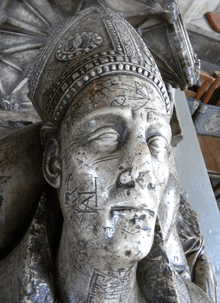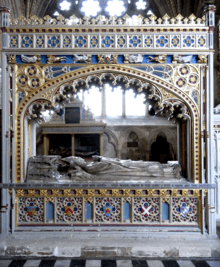Edmund Stafford
Edmund Stafford (1344 – 3 September 1419) was Bishop of Exeter from 1395 to his death in 1419.
Edmund Stafford | |
|---|---|
| Bishop of Exeter | |
 Detail from alabaster effigy of Edmund Stafford in Exeter Cathedral | |
| Appointed | 15 January 1395 |
| Term ended | 3 September 1419 |
| Predecessor | Thomas Brantingham |
| Successor | John Catterick |
| Orders | |
| Consecration | 20 June 1395 |
| Personal details | |
| Born | 1344 |
| Died | 3 September 1419 |
| Buried | Exeter Cathedral |
| Denomination | Catholic |
| Previous post | Dean of York |

Origins
He was the second son of Sir Richard Stafford of Clifton by his wife Isabel Vernon, a daughter of Sir Richard Vernon of Haddon Hall in Derbyshire.[1]
Career
Stafford attended Oxford University, graduating BA in 1363; in the same year he was appointed a canon of Lichfield. He obtained a BCL in 1369 and a DL in 1385, the same year he became dean of York. He also held the Rectorship of Clifton Campville, his family lands. Whilst dean of York, he was named keeper of the Privy Seal on 4 May 1389, keeping that role until February 1396.[2] Later that year, he was appointed Lord Chancellor of England, holding it until 1399 when, on the accession of Henry IV, he was replaced. Two years later he again took up the role, appointed as part of a reaction against Henry's dependence on Lancastrians. He was replaced by Henry Beaufort in February 1403.[3] Edmund continued to serve the King, trying petitions in Parliaments in 1404 and 1406 and being appointed one of the King's councillors in the parliament of 1406.
Stafford was nominated to the see of Exeter on 15 January 1395 and consecrated on 20 June 1395.[4] Visits to his diocese were few when he was on government office; he did visit extensively in the time between appointments as Chancellor and after 1403 he became more involved, with extensive vistas in 1404, 1411 and 1414.[1]
Death and burial
Stafford died on 3 September 1419[1][4] and was buried in the Lady Chapel of Exeter Cathedral, where survives his elaborate monument with recumbent alabaster effigy. His family lands and the barony passed to Thomas Stafford. His executors are named in 1421.[5]
Citations
- Oxford Dictionary of National Biography, Edmund Stafford
- Fryde, et al. Handbook of British Chronology p. 95
- Fryde, et al. Handbook of British Chronology p. 87
- Fryde, et al. Handbook of British Chronology p. 247
- second entry http://aalt.law.uh.edu/H5/CP40no641/bCP40no641dorses/IMG_1041.htm
References
- Fryde, E. B.; Greenway, D. E.; Porter, S.; Roy, I. (1996). Handbook of British Chronology (Third revised ed.). Cambridge: Cambridge University Press. ISBN 0-521-56350-X.
| Political offices | ||
|---|---|---|
| Preceded by John Waltham |
Lord Privy Seal 1389–1396 |
Succeeded by Guy Mone |
| Preceded by Thomas Arundel |
Lord Chancellor 1396–1399 |
Succeeded by Thomas Arundel |
| Preceded by John Scarle |
Lord Chancellor 1401–1403 |
Succeeded by Henry Beaufort |
| Catholic Church titles | ||
| Preceded by Thomas Brantingham |
Bishop of Exeter 1395–1419 |
Succeeded by John Catterick |
| Peerage of England | ||
| Preceded by Richard Stafford |
Baron Stafford of Clifton 1380–1419 |
Succeeded by Thomas Stafford |